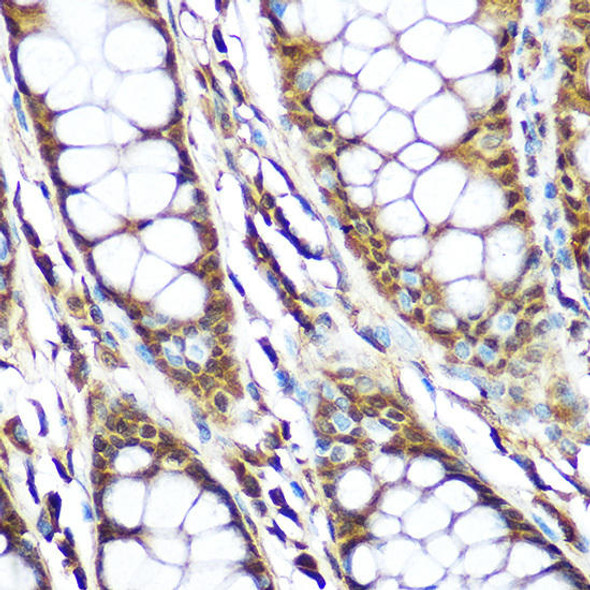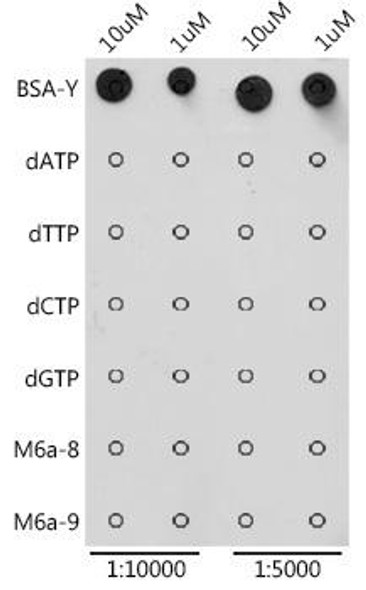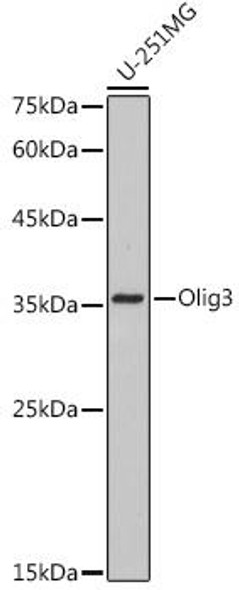Description
Anti-LIG3 Antibody (CAB1887)
The Lig3 Polyclonal Antibody (CAB1887) is a valuable tool for researchers exploring DNA ligase 3 (Lig3) protein, an essential enzyme in DNA replication and repair processes. This rabbit polyclonal antibody is highly specific and reactive with human samples, making it perfect for use in Western blot applications.Lig3 plays a crucial role in maintaining genomic stability and preventing DNA damage accumulation. Dysregulation of Lig3 function has been linked to various diseases, including cancer and neurodegenerative disorders. By targeting the Lig3 protein, researchers can gain insights into its function and potentially develop therapeutic strategies for conditions related to DNA repair deficiencies.
With its high specificity and sensitivity, the Lig3 Polyclonal Antibody is an invaluable tool for studying DNA repair mechanisms and exploring the role of Lig3 in disease development. This antibody can enable accurate detection and analysis of Lig3 protein expression in different cell types, advancing our understanding of the molecular pathways involved in DNA repair and replication.
| Antibody Name: | Anti-LIG3 Antibody |
| Antibody SKU: | CAB1887 |
| Antibody Size: | 20uL, 50uL, 100uL |
| Application: | WB IP |
| Reactivity: | Human |
| Host Species: | Rabbit |
| Immunogen: | Recombinant fusion protein containing a sequence corresponding to amino acids 730-1009 of human LIG3 (NP_039269.2). |
| Application: | WB IP |
| Recommended Dilution: | WB 1:500 - 1:2000 IP 1:50 - 1:200 |
| Reactivity: | Human |
| Positive Samples: | BT474, SW480, HeLa, HT-29, Jurkat |
| Immunogen: | Recombinant fusion protein containing a sequence corresponding to amino acids 730-1009 of human LIG3 (NP_039269.2). |
| Purification Method: | Affinity purification |
| Storage Buffer: | Store at -20°C. Avoid freeze / thaw cycles. Buffer: PBS with 0.02% sodium azide, 50% glycerol, pH7.3. |
| Isotype: | IgG |
| Sequence: | AGGH DDAT LARL QNEL DMVK ISKD PSKI PSWL KVNK IYYP DFIV PDPK KAAV WEIT GAEF SKSE AHTA DGIS IRFP RCTR IRDD KDWK SATN LPQL KELY QLSK EKAD FTVV AGDE GSST TGGS SEEN KGPS GSAV SRKA PSKP SAST KKAE GKLS NSNS KDGN MQTA KPSA MKVG EKLA TKSS PVKV GEKR KAAD ETLC QTKV LLDI FTGV RLYL PPST PDFS RLRR YFVA FDGD LVQE FDMT SATH VLGS RDKN PAAQ QVSP EWIW ACIR KRRL VAPC |
| Gene ID: | 3980 |
| Uniprot: | P49916 |
| Cellular Location: | Mitochondrion, Mitochondrion, Nucleus |
| Calculated MW: | 95kDa/102kDa/106kDa/112kDa |
| Observed MW: | 113kDa |
| Synonyms: | LIG3, LIG2 |
| Background: | This gene is a member of the DNA ligase family. Each member of this family encodes a protein that catalyzes the joining of DNA ends but they each have a distinct role in DNA metabolism. The protein encoded by this gene is involved in excision repair and is located in both the mitochondria and nucleus, with translation initiation from the upstream start codon allowing for transport to the mitochondria and translation initiation from a downstream start codon allowing for transport to the nucleus. Additionally, alternate transcriptional splice variants, encoding different isoforms, have been characterized. |
| UniProt Protein Function: | LIG3: Interacts with DNA-repair protein XRCC1 and can correct defective DNA strand-break repair and sister chromatid exchange following treatment with ionizing radiation and alkylating agents. Belongs to the ATP-dependent DNA ligase family. 2 isoforms of the human protein are produced by alternative splicing. |
| UniProt Protein Details: | Protein type:EC 6.5.1.1; Ligase Chromosomal Location of Human Ortholog: 17q11.2-q12 Cellular Component: nucleoplasm; mitochondrion; chromosome; synaptonemal complex; nucleus Molecular Function:protein binding; DNA binding; DNA ligase activity; zinc ion binding; DNA ligase (ATP) activity; ATP binding Biological Process: mitochondrial DNA repair; mitochondrion organization and biogenesis; negative regulation of DNA recombination; V(D)J recombination; base-excision repair, DNA ligation; DNA repair; cell cycle; lagging strand elongation; double-strand break repair via nonhomologous end joining; DNA ligation; nucleotide-excision repair; base-excision repair; cell division; double-strand break repair |
| NCBI Summary: | This gene is a member of the DNA ligase family. Each member of this family encodes a protein that catalyzes the joining of DNA ends but they each have a distinct role in DNA metabolism. The protein encoded by this gene is involved in excision repair and is located in both the mitochondria and nucleus, with translation initiation from the upstream start codon allowing for transport to the mitochondria and translation initiation from a downstream start codon allowing for transport to the nucleus. Additionally, alternate transcriptional splice variants, encoding different isoforms, have been characterized. [provided by RefSeq, Jul 2008] |
| UniProt Code: | P49916 |
| NCBI GenInfo Identifier: | 251757259 |
| NCBI Gene ID: | 3980 |
| NCBI Accession: | P49916.2 |
| UniProt Related Accession: | P49916 |
| Molecular Weight: | |
| NCBI Full Name: | DNA ligase 3 |
| NCBI Synonym Full Names: | DNA ligase 3 |
| NCBI Official Symbol: | LIG3 |
| NCBI Official Synonym Symbols: | LIG2; LIG3alpha |
| NCBI Protein Information: | DNA ligase 3 |
| UniProt Protein Name: | DNA ligase 3 |
| UniProt Synonym Protein Names: | DNA ligase III; Polydeoxyribonucleotide synthase [ATP] 3 |
| Protein Family: | DNA ligase |
| UniProt Gene Name: | LIG3 |
| UniProt Entry Name: | DNLI3_HUMAN |








